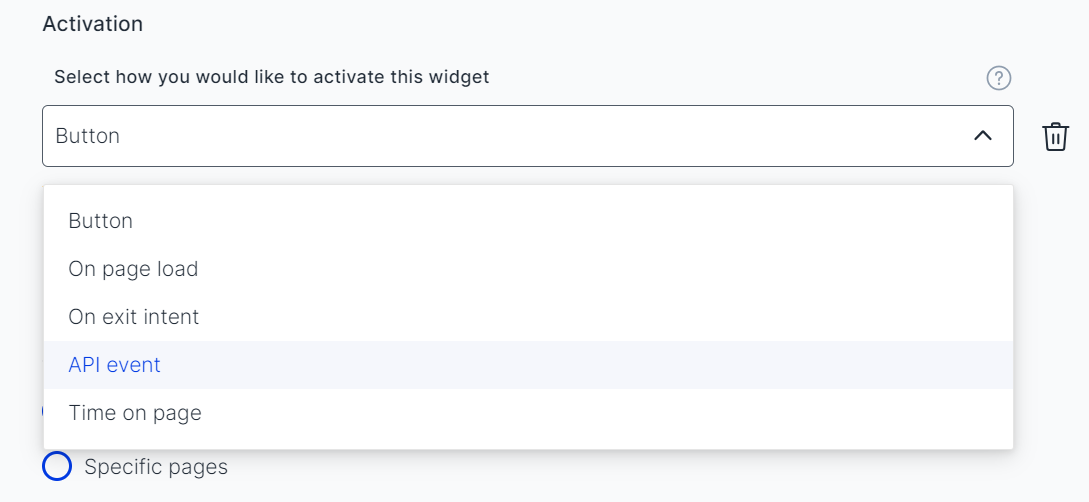For website or web application
This is a technical documentation of the APIFor more user-case oriented examples see Website widget: API examples.
What's mentioned below ONLY works with the space snippet, i.e. the global API key.
Installation
window.onUsersnapLoad = function(api) {
api.init();
}
var script = document.createElement('script');
script.defer = 1;
script.src = 'https://widget.usersnap.com/global/load/<GLOBAL_API_KEY>?onload=onUsersnapLoad';
document.getElementsByTagName('head')[0].appendChild(script);API object
interface GlobalApi {
init: (options: InitOptions) => Promise<void>,
destroy: () => Promise<void>,
logEvent: (eventName: string) => Promise<void>,
on: (eventName: string, callback: (event: any) => void) => void,
off: (eventName: string, callback: (event: any) => void) => void,
}init()
api.init({
custom: {
applicationLanguage : "de",
},
user: {
userId: "123",
email: "[email protected]",
},
locale: 'de',
});The init function initializes the global api. It must be called before calling any other api method.
Params
optionsoptions.custom: Record<string, any>– An object holding custom data. This data will be passed along with every feedbackoptions.user– An object holding information about the current useroptions.user.email: string– Will be pre-filled in the widget and attached to every feedbackoptions.user.userId: string– Can be used for determining whether to show a widget or notoptions.locale: string– Language in which widgets should be displayedoptions.useSystemFonts: boolean– Can be used to disable loading external fonts. Defaults tofalseoptions.useLocalStorage: boolean– Can be used to disable usage of localStorage. Defaults totrueoptions.nativeScreenshot: boolean– Can be used to enable the usage of the native screenshot feature. Defaults tofalseoptions.collectGeoLocation: 'all' | 'none'– can be used to disable the collection of IP and geo location. Defaults to'all'
Returns Promise<void>
Promise<void>destroy()
api.destroy()Destroys the global api and removes all widgets from the DOM of the webpage.
After calling destroy() it is necessary to call init() before calling any other method.
Returns Promise<void>
Promise<void>logEvent()
api.logEvent('my-event') // will open a widget if one was configured for this eventCan be used to trigger widgets by specific event names.
Params
eventName: string– the name of the event
Returns Promise<void>
Promise<void>on()
function handleSubmit() {
console.log('Widget was submitted')
}
api.on('submit', handleSubmit)Registers an event handler for widget events.
For a detailed list of available events and how they can be used see section Widget Events
Params
eventName: string– the name of the widget event you want to listen tocallback: (event: WidgetEvent) => void– callback to handle the event. The structure of the received object depends on the event.
Returns void
voidoff()
api.off('submit', handleSubmit)Removes an event handler
Params
eventName: string– the name of the widget event want to remove the listener fromcallback: (event: WidgetEvent) => void– same callback that was used for registering the event
Returns void
voidWidget Events
open– A widget was opened.close– A widget was closedbeforeSubmit– Before form values are submittedsubmit– After form values were submitted
open event
open eventtype ValueKey = 'assignee' | 'custom' | 'labels' | 'visitor'
interface OpenEvent {
apiKey: string,
api: {
setValue: (key: ValueKey, value: any) => void,
},
}apiKey– API key of the widget that was openedapi.setValue– method to set form values
Please note that for the open event, you should use the "API event" for triggering the widget in the activation settings of your project:

Example
function handleWidgetOpened(event) {
// You can check whether a specific widget was called
if (event.apiKey !== '<PROJECT_API_KEY>') return;
// Set Assignee. A User with this email has to exist in your Usersnap account
event.api.setValue('assignee', '[email protected]')
// Set custom data
event.api.setValue('custom', { applicationLanguage : 'de' })
// Set labels
event.api.setValue('labels', ['bug', 'critical'])
// Set email
event.api.setValue('visitor', '[email protected]')
}
api.on('open', handleWidgetOpened)close event
close eventinterface CloseEvent {
apiKey: string,
isCancel: boolean,
}apiKey– API key of the widget that was closedisCancel– istruein case the widget was closed before submitting a feedback item
Example
function handleWidgetClosed(event) {
if (event.isCancel) {
// do something
}
}
api.on('close', handleWidgetClosed)beforeSubmit event
beforeSubmit eventtype ValueKey = 'assignee' | 'custom' | 'labels' | 'visitor'
interface BeforeSubmitEvent {
apiKey: string,
api: {
setValue (key: ValueKey, value: any) => void,
}
values: {
assignee?: string,
custom?: any,
labels?: string,
visitor: string,
}
}apiKey– API key of the widget that will be submittedapi.setValue– method to set form values. Allows changing values before they are submitted.values– values that will be submitted
Example
function handleBeforeSubmit(event) {
var labels = event.values.labels
if (labels && labels.includes('bug')) {
event.api.setValue('assignee', '[email protected]')
}
}
api.on('beforeSubmit', handleBeforeSubmit)submit event
submit eventinterface CloseEvent {
apiKey: string,
}apiKey– API key of the widget that was submitted
Example
function handleSubmit() {
// do something
}
api.on('submit', handleSubmit)